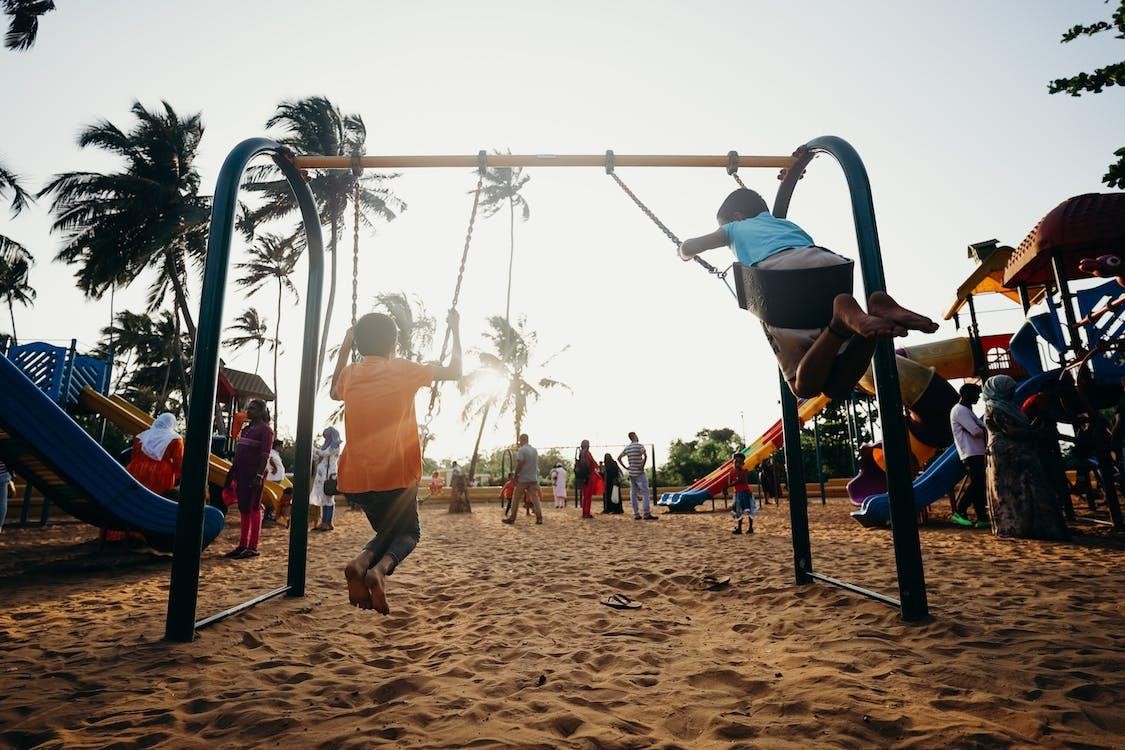Have you ever wondered if there’s a reason some playgrounds look more appealing than others?
The answer to that is playground aesthetics.
Playground aesthetics refer to the visual appeal and design of a playground. These variables are crucial in creating an engaging and stimulating environment for children.
Through effective landscaping design, playgrounds can be improved to become more effective, functional, and fun for children. In this article, we’ll discuss the impact of playground aesthetics and some creative solutions you can utilize to improve your playground.
Table of Contents
What Is Playground Aesthetics?
Playground aesthetics refers to a playground environment’s visual appeal and overall appearance. It involves carefully considering both functional and aesthetic aspects to create a safe, practical, and visually stimulating space.
Besides installing and placing quality playground equipment, playground aesthetics refer to other variables that make up the space. It encompasses elements such as design, layout, colors, materials, and landscaping that contribute to the space’s beauty, harmony, and attractiveness.
Aesthetically pleasing environments have been known to promote positive feelings, creativity, and a sense of connection with nature. This is why improving playground aesthetics can contribute to the emotional and psychological well-being of children and guardians alike.
Improving Playground Landscape Through Creative Landscaping

By prioritizing playground aesthetics, communities can create spaces that promote physical activity, social interaction, and the overall quality of life for residents and visitors alike.
Here are some creative landscaping ideas that help improve playground aesthetics:
Incorporating Natural Elements
Incorporating natural elements into playground design is crucial to creating an engaging and aesthetically pleasing environment for children. Natural elements can include rocks, trees, and water features.
- Rocks and boulders: These can serve multiple purposes in a playground, such as climbing structures or seating areas. They can also create or set borders on a path as part of a natural obstacle course.
- Trees: These provide shade, making the playground more comfortable during hot seasons while adding to the overall aesthetic appeal of the area. Trees can also be used as part of durable play structures, such as treehouses or swings.
- Water features: Installing ponds or streams can also be great additions to your playground’s design. These features can provide a sensory experience for children, allowing them to interact with water in a safe and controlled environment.
It’s important to consider safety when incorporating natural elements. For example, rocks and boulders should be securely placed to prevent tipping, and water features should be designed to minimize the risk of drowning.
By carefully selecting and positioning these elements, playgrounds can become more than just a place for physical activity – they can become a place for children to connect with nature and engage their senses.
Using Colorful Plants
Incorporating colorful plants into playground design can significantly enhance its aesthetic appeal. Plants not only add color and texture but also contribute to a healthier environment by improving air quality.
When selecting plants for a playground, it’s important to consider their hardiness, maintenance requirements, and safety. Plants in playgrounds should require minimal maintenance and be non-toxic and non-allergenic to ensure children’s safety.
Here are some plant options commonly used in playground landscaping:
- Marigolds: These are hardy, vibrant flowers that can withstand high foot traffic. They are also known to deter certain pests, making them a practical choice for playgrounds.
- Sunflowers: Sunflowers can add height and a pop of color to any playground. They are also fascinating for children as they can grow to be quite tall.
- Creeping thyme: This is a durable ground cover that can withstand foot traffic. It produces small, pink flowers and can be a great alternative to grass.
- Lavender: Lavender is a hardy plant that produces a calming scent. It’s also known to attract butterflies, adding an extra element of interest for children.
- Fescue grass: This type of grass is durable, low-maintenance, and stays green year-round, making it an excellent choice for playgrounds.
Pest-Free Playtime: Installing and maintaining plants can attract nasty pests that could harm kids using your playground. Contact professionals offering pest control services in Medford, Oregon, to ensure that a playground’s fun spaces are pest-free.
Applying Functional Landscaping
Functional landscaping refers to the integration of practical elements into the playground design. This enhances the aesthetics and also improves the space’s usability.
Seating Areas
One of the key aspects of functional landscaping is the inclusion of seating areas. They provide a place for parents and caregivers to rest while supervising their children.
Benches, picnic tables, and shaded areas are typical examples of seating options that can be incorporated into the playground design.
Storage Spaces
Another important aspect of functional landscaping is the provision of storage spaces. These can be used to store play equipment, personal belongings, or waste bins.
Storage spaces help to keep the playground tidy and organized, contributing to a more pleasant play environment.
Accessibility Options
According to the Americans with Disabilities Act (ADA), playgrounds should be designed to be accessible to everyone, and functional landscaping can play a crucial role in achieving this.
Functional landscaping can include elements that aid navigation and accessibility through various design additions. For instance, pathways and ramps can be incorporated into the playground design to ensure it is accessible to all users, including those with mobility challenges.
Incorporating Interactive Elements
Interactive elements in playgrounds are not only fun but also contribute significantly to children’s development. They stimulate children’s senses, promote physical activity, and encourage social interaction.
Interactive elements can range from simple to complex installations. Here are some examples:
Musical instruments: Outdoor musical instruments like drums, xylophones, or chimes can be a great addition to any playground. They allow children to explore sounds and rhythms, fostering their musical and auditory development.
Water features: Water play areas with pumps, channels, and water wheels can provide endless fun and learning opportunities. They help children understand basic principles of physics such as gravity and water flow.
Interactive panels: Panels with puzzles, mazes, or tactile elements can be mounted on playground structures. They can help develop fine motor skills and problem-solving abilities.
Incorporating interactive elements in playgrounds can significantly enhance children’s play experience and contribute to their overall development. It’s important to ensure that these elements are safe, durable, and suitable for the age group that uses the playground.
Installing Lighting
Lighting is a crucial aspect of playground design that often goes overlooked.
Proper lighting can extend the usability of a playground into the early morning and late evening hours, providing more opportunities for play. It can also enhance safety by illuminating potential hazards and discouraging unwanted activities after dark.
Here are several lighting options fit for a playground:
Ambient lighting: This is the main source of light in the playground. It should be bright enough to illuminate the entire area but not so bright that it causes glare. LED lights are a popular choice for ambient lighting due to their energy efficiency and long lifespan.
Task lighting: This type of lighting is used to illuminate specific areas or features of the playground, such as a climbing structure or a picnic area. Task lighting should be carefully positioned to avoid casting shadows on the play area.
Accent lighting: Accent lighting is used to highlight architectural features or landscaping elements, such as a mural or a water feature. It can create a dramatic effect and enhance the aesthetic appeal of the playground.
Security lighting: Security lighting is used to deter unwanted activities after dark. It should be bright enough to cover all areas of the playground, including entrances and exits.
Playground lights should be shielded to direct light downwards and prevent it from spilling into unwanted areas. Timers or motion sensors can also ensure that lights are only on when needed.
Use A Light Touch: When installing lighting in a playground, it’s important to consider the impact on the surrounding environment. For example, light pollution can disrupt local wildlife and bother nearby residents.
Conclusion

A well-designed playground with pleasing aesthetics can enhance the overall experience for children and adults alike, making it more inviting, engaging, and enjoyable to spend time outdoors.
These ideas range from incorporating natural elements like colorful plants to designing a playground with accessibility for all in mind. Each idea is designed to create a visually appealing, functional, and engaging space for children to play and learn.
















